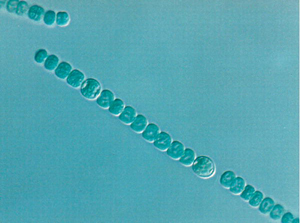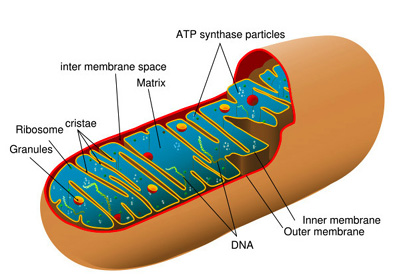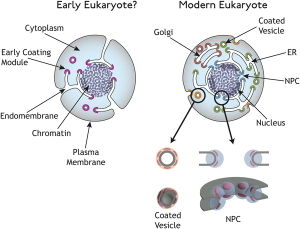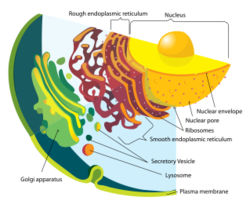Cell (biology)


A cell is a metabolically active unit containing proteins and nucleic acids enclosed by a selectively permeable membrane. The cell is an essential structural and functional component of all living organisms, and it is from cells that all parts of organisms are formed.
Some organisms, such as certain protists, are unicellular, with much of their life cycle spent as a single cell, except when they are dividing to form daughter cells. Other organisms, such as humans, are multicellular, (humans have an estimated 100 trillion or 1014 cells and everyone of those has one of over 200 cell types[1]; a typical cell size is 10 µm, a typical cell mass 1 nanogram). All vertebrate eggs are single cells, and the largest known cell is an ostrich egg. The cell theory, developed in 1839 by Schleiden (1804-1881) and Schwann (1810-1882), states that all organisms are composed of one or more cells; all cells come from preexisting cells; all vital functions of an organism occur within cells, and cells contain the hereditary information necessary for regulating cell functions and for transmitting information to the next generation of cells. The word cell comes from the Latin cellula, a small room, and was chosen by Robert Hooke when he compared the cork cells he saw through the microscope to the modest rooms monks inhabited.[2]
Overview
Properties of cells
Each cell is at least somewhat self-contained and self-maintaining: it can take in nutrients, and convert these nutrients into chemically useful energy and building blocks for cell components such as proteins and nucleic acids. Some cells in multi-cellular organisms carry out specialized functions, and others carry out all the general functions needed to maintain life. Each cell stores coded information accumulated from the action of natural selection action on its its ancestors in the form of nucleic acid sequences of its the genes (made of DNA). This ancestral archive is exploited for organism survival by living cells by being used to specify RNA and protein structures, functions, and phenotypic adaptations of the cell.
All cells share several abilities[3]:
- Reproduction by cell division (binary fission, mitosis or meiosis).
- Use of enzymes and other proteins coded for by DNA genes and made via messenger RNA intermediates and ribosomes.
- Metabolism, including taking in raw materials, building cell components, converting energy, molecules and releasing by-products. The functioning of a cell depends upon its ability to extract and use chemical energy stored in organic molecules. This energy is derived from metabolic pathways.
- Response to external and internal stimuli such as changes in temperature, pH or nutrient levels.
- Cell contents are contained within a cell surface membrane that contains proteins and a lipid bilayer.
Some prokaryotic cells contain important internal membrane-bound compartments, but eukaryotic cells have a highly specialized endomembrane system characterized by regulated traffic and transport of vesicles.[4]
Subcellular components
All cells, whether prokaryotic or eukaryotic, have a membrane which envelopes the cell, separates its interior from its environment, regulates what moves in and out, and maintains the electric potential of the cell. Inside the membrane, a salty cytoplasm takes up most of the volume. All cells possess DNA, the hereditary material of genes, and RNA, containing the information necessary to build various proteins such as enzymes, the cell's primary machinery. There are also other kinds of biomolecules in cells.
Cell membrane: A cell's defining boundary
The cytoplasm of a cell is surrounded by a plasma membrane. This serves to separate and protect a cell from its surrounding environment. Without the plasma membrane the complex organization of the cell's interior would dissolve in its larger invading environment. The membrane is made mostly from a double layer of lipids (hydrophobic fat-like molecules) and hydrophilic phosphate residues. Hence the layer is called a phospholipid bilayer. The membrane itself consists of a rich dynamic micro-system of bio-molecules mutually interacting and interacting with its extra- and intra-cellular environments. Embedded within this membrane is a variety of protein molecules that act as channels and pumps that move different molecules into and out of the cell. The membrane is 'semi-permeable', in that it can either let a substance (molecule or ion) pass through freely, pass to a limited extent or not pass through at all. Cell surface membranes also contain receptor proteins that allow cells to detect external signalling molecules such as hormones, many of these receptors are coupled to the channels and pumps that control the contents of the cytoplasm.
The plasma membrane in plants and prokaryotes is usually covered by an outer cell wall.
Cytoskeleton: A cell's scaffold
The cytoskeleton acts to organize and maintain the cell's shape; anchors organelles in place; helps during endocytosis, the uptake of external materials by a cell, and cytokinesis, the separation of daughter cells after cell division; and provides both stability and propulsion of the cytoplasm for growth and movement. The eukaryotic cytoskeleton is composed of microfilaments, intermediate filaments and microtubules. There are many families of other proteins associated with the cytoskeletal filament proteins, each controlling a cell's structure by directing, bundling, and aligning the filaments.
Genetic material
Two different kinds of genetic material exist: DNA and RNA. Most organisms use DNA for their long-term information storage, but some viruses (e.g., retroviruses) have RNA as their genetic material. The biological information contained in an organism is encoded in its DNA or RNA sequence. RNA is also used for information transport (e.g., mRNA) and enzymatic functions (e.g., ribosomal RNA) in organisms that use DNA for the genetic code itself. Proteins can bind to genetic material and either block or promote their operation. Prokaryotic genetic material is organized in a simple circular DNA molecule (the bacterial chromosome) in the nucleoid region of the cytoplasm. Eukaryotic genetic material is divided into different, linear molecules called chromosomes inside a discrete nucleus, usually with additional genetic material in some organelles like mitochondria and chloroplasts (see endosymbiotic theory).
A human cell has genetic material both in the nucleus (the nuclear genome) and in the mitochondria (the mitochondrial genome). In humans the nuclear genome is divided into 46 linear DNA molecules called chromosomes and the mitochondrial genome is a circular DNA molecule that is separate from the nuclear DNA. Although the mitochondrial genome is very small, it codes for some important proteins. Like all vertebrates, each person inherits mitochondrial DNA only from his or her mother. That's because only the nucleus of the sperm cell becomes part of the fertilized egg, the zygote. The mitochondrial DNA in the ovum divides with the zygote and supplies the entire organism that develops from it. Foreign genetic material (most commonly DNA) can also be artificially introduced into the cell by a process called transfection. This can be transient, if the DNA is not inserted into the cell's genome, or stable, if it is.
Organelles
The human body contains many different organs, such as the heart, lung, and kidney, with each organ performing a different function. Cells also have a set of 'little organs', called organelles, that are adapted and/or specialized for carrying out one or more vital functions. Membrane-bound organelles are found only in eukaryotes.
The cell nucleus is the most conspicuous organelle. It houses the cell's chromosomes, and is the place where almost all DNA replication and RNA synthesis occur. The nucleus is spheroid in shape and separated from the cytoplasm by a double membrane called the nuclear envelope. The nuclear envelope isolates and protects a cell's DNA from various molecules that could accidentally damage its structure or interfere with its processing. During processing, DNA is transcribed, or copied into a special RNA, called mRNA. This mRNA is then transported out of the nucleus, where it is translated into a specific protein molecule. In prokaryotes, DNA processing takes place in the cytoplasm.

Mitochondria are self-replicating organelles that occur in various numbers, shapes, and sizes in the cytoplasm of all eukaryotic cells. As mitochondria have their own genome that is separate and distinct from the nuclear genome of a cell, they play a critical role in generating energy in the eukaryotic cell, a process involving a number of complex metabolic pathways. Chloroplasts are larger than mitochondria, and convert solar energy into a chemical energy ("food") via photosynthesis. Like mitochondria, chloroplasts have their own genome. Chloroplasts are found only in photosynthetic eukaryotes, like plants and algae. There are a number of plant organelles that are modified chloroplasts; they are broadly called plastids, and are often involved in storage.
The endoplasmic reticulum (ER) is the transport network for molecules targeted for certain modifications and specific destinations, as compared to molecules that will float freely in the cytoplasm. The ER has two forms: the rough ER, which has ribosomes on its surface, and the smooth ER, which lacks them. Translation of the mRNA for those proteins that will either stay in the ER or be exported from the cell occurs at the ribosomes attached to the rough ER. The smooth ER is important in lipid synthesis, detoxification and as a calcium reservoir. The Golgi apparatus, sometimes called a Golgi body or Golgi complex is the central delivery system for the cell and is a site for protein processing, packaging, and transport. Both organelles consist largely of heavily-folded membranes.
The ER contains many ribosomes (the protein production machines) : The ribosome is a large complex composed of many molecules, including RNAs and proteins, and processes the genetic instructions carried by an mRNA. The process of converting an mRNA's genetic code into the exact sequence of amino acids that make up a protein is called translation. Protein synthesis is extremely important to all cells, and therefore a large number of ribosomes — sometimes hundreds or even thousands — can be found throughout a cell. Ribosomes are found in both prokaryotes and eukaryotes, and in eukaryotes they can be bound to regions of endoplasmic reticulum membrane devoted to protein secretion.
Lysosomes and peroxisomes are often referred to as the garbage disposal system of a cell. Both organelles are somewhat spherical, bound by a single membrane, and rich in digestive enzymes, naturally-occurring proteins that speed up biochemical processes. For example, lysosomes can contain more than three dozen enzymes for degrading proteins, nucleic acids, and certain sugars called polysaccharides. Here we can see the importance behind compartmentalization of the eukaryotic cell; the cell could not house such destructive enzymes if they were not contained in a membrane-bound system.
The centrosome produces the microtubules of a cell - a key component of the cytoskeleton. It directs the transport through the ER and the Golgi apparatus. Centrosomes are composed of two centrioles, which separate during cell division and help in the formation of mitotic apparatus. A single centrosome is present in the animal cells. They are also found in some fungi and algae cells.
Vacuoles store food and waste. Some vacuoles store extra water. They are often described as liquid filled space and are surrounded by a membrane. Some cells, most notably Amoeba have contractile vacuoles, which are able to pump water out of the cell if there is too much water.|}
Structural differences of two main evolutionary lineages of cells
The first cells lacked well developed nuclei and are classified as prokaryotic cells. Eukaryotic cells are defined as cells in which a nucleus is present. Prokaryotic cells are usually more compact in size, often have a unicellular existence, while eukaryotic cells are larger, with more complex internal membrane based structures. Most familiar multi-cellular organisms are composed of eukaryotic cells.
Prokaryotic cells
Prokaryotes are distinguished from eukaryotes on the basis of nuclear organization, specifically their lack of a nuclear membrane. An equally important distinction is that noprokatyotic cell carries out phagacytosis to engulf food particles, or carries out pinocytosis. Nutients are taken up in a soluble form through specialized transport protein present in the prokayotic cell membrane. Prokaryotes also lack most of the intracellular organelles and structures that are characteristic of eukaryotic cells (an important exception is the ribosomes, which are present in both prokaryotic and eukaryotic cells). Most of the functions of organelles, such as mitochondria, chloroplasts, and the Golgi apparatus, are taken over by the prokaryotic plasma membrane. Prokaryotic cells have three architectural regions: appendages called flagella and pili — proteins attached to the cell surface; a cell envelope consisting of a capsule, a cell wall, and a plasma membrane; and a cytoplasmic region that contains the DNA and ribosomes and various sorts of inclusions. Other differences include:
- The plasma membrane (a phospholipid bilayer) separates the interior of the cell from its environment and serves as a filter and communications beacon.
- Most prokaryotes have a cell wall (some exceptions are Mycoplasma (a bacterium) and Thermoplasma (an archaean)). It consists of peptidoglycan in bacteria, and acts as an additional barrier against exterior forces. It also prevents the cell from "exploding" (cytolysis) from osmotic pressure against a hypotonic environment. A cell wall is also present in some eukaryotes like fungi and plants, but has a different chemical composition.
- A prokaryotic chromosome is usually a circular molecule (an exception is that of the bacterium Borrelia burgdorferi, which causes Lyme disease). Even without a real nucleus, the DNA is condensed in a nucleoid. Prokaryotes can carry extrachromosomal DNA elements called plasmids, which are usually circular. Plasmids can carry additional functions, such as antibiotic resistance.
Eukaryotic cells

Eukaryotic cells are about 10 times the size of a typical prokaryote and can be as much as 1000 times greater in volume. The major difference between prokaryotes and eukaryotes is that eukaryotic cells contain membrane-bound compartments in which specific metabolic activities take place. Important among these is the presence of a nucleus, a membrane-delineated compartment that houses the eukaryotic cell's DNA. It is this nucleus that gives the eukaryote its name, which means 'true nucleus'. Other differences include:
- The plasma membrane resembles that of prokaryotes in function, with minor differences in the setup. Cell walls may or may not be present.
- The eukaryotic DNA is organized in one or more linear molecules, called chromosomes, which are associated with histone proteins. All chromosomal DNA is stored in the cell nucleus, separated from the cytoplasm by a membrane. Some eukaryotic organelles also contain some DNA.
- Eukaryotes can move using cilia or flagella. The flagella are more complex than those of prokaryotes.
| Prokaryotes | Eukaryotes | |
|---|---|---|
| Typical organisms | bacteria, archaea | protists, fungi, plants, animals |
| Typical size | ~ 1-10 µm | ~ 10-100 µm (sperm cells, apart from the tail, are smaller) |
| Type of nucleus | nucleoid region; no real nucleus | real nucleus with double membrane |
| DNA | circular (usually) | linear molecules (chromosomes) with histone proteins |
| RNA-/protein-synthesis | coupled in cytoplasm | RNA-synthesis inside the nucleus protein synthesis in cytoplasm |
| Ribosomes | 50S+30S | 60S+40S |
| Cytoplasmic structure | very few structures | highly structured by endomembranes and a cytoskeleton |
| Cell movement | flagella made of flagellin | flagella and cilia made of tubulin |
| Mitochondria | none | one to several dozen (though some lack mitochondria) |
| Chloroplasts | none | in algae and plants |
| Organization | usually single cells | single cells, colonies, higher multicellular organisms with specialized cells |
| Cell division | Binary fission (smallness obscures division details) | Mitosis (fission or budding) Meiosis |
| Typical animal cell | Typical plant cell | |
|---|---|---|
| Organelles |
|
|
| Additional structures |
|
Cell functions
Cell growth and metabolism
- Main articles: Cell growth, Cell metabolism
Between successive cell divisions, cells grow through the functioning of cellular metabolism. Cell metabolism is the process by which individual cells process nutrient molecules. Metabolism has two distinct divisions: catabolism, in which the cell breaks down complex molecules to produce energy and reducing power, and anabolism, wherein the cell uses energy and reducing power to construct complex molecules and perform other biological functions. Complex sugars consumed by the organism can be broken down into a less chemically-complex sugar molecule called glucose. Once inside the cell, glucose is broken down to make adenosine triphosphate (ATP), a form of energy, via two different pathways.
The first pathway, glycolysis, requires no oxygen and is referred to as anaerobic metabolism. Each reaction is designed to produce some hydrogen ions that can then be used to make energy packets (ATP). In prokaryotes, glycolysis is the only method used for converting energy. The second pathway, called the Krebs cycle, or citric acid cycle, occurs inside the mitochondria and is capable of generating enough ATP to run all the cell functions.
Creation of new cells
Cell division involves a single cell dividing into two 'daughter' cells. This leads to growth in multicellular organisms (the growth of tissue) and to procreation (vegetative reproduction) in unicellular organisms. Prokaryotic cells divide by binary fission. Eukaryotic cells usually undergo a process of nuclear division, called mitosis, followed by division of the cell, called cytokinesis. A diploid cell may also undergo meiosis to produce haploid cells, usually four. Haploid cells serve as gametes in multicellular organisms, fusing to form new diploid cells. DNA replication, or the process of duplicating a cell's genome, is required every time a cell divides. Replication, like all cellular activities, requires specialized proteins.
Protein synthesis
Cells are capable of synthesizing new proteins, which are essential for the modulation and maintenance of cellular activities. This involves forming new protein molecules from amino acid building blocks based on information encoded in DNA/RNA. Protein synthesis generally consists of two major steps: transcription and translation. Transcription is the process where genetic information in DNA is used to produce a complimentary RNA strand. This strand is then processed to give mRNA, which is free to migrate through the cell. mRNA molecules bind to ribosomes located in the cytosol, where they are translated into polypeptide sequences. The ribosome mediates the formation of a polypeptide sequence based on the mRNA sequence. The mRNA sequence directly relates to the polypeptide sequence by binding to transfer RNA (tRNA) adapter molecules in binding pockets within the ribosome. The new polypeptide then folds into a functional 3D protein molecule.
History
- 1632–1723: Antonie van Leeuwenhoek grinds lenses, builds a microscope and draws protozoa, such as Vorticella from rain water, and bacteria.
- 1665: Robert Hooke discovers cells in cork, then in living plant tissue using an early microscope.
- 1839: Theodor Schwann and Matthias Jakob Schleiden propose that plants and animals are made of cells, concluding that cells are a common unit of structure and development, and thus founding the cell theory.
- The belief that life forms can arise spontaneously (generatio spontanea) is contradicted by Louis Pasteur (1822–1895) (although Francesco Redi had performed an experiment in 1668 that suggested the same conclusion).
- Rudolph Virchow states that cells always emerge from cell divisions (omnis cellula ex cellula).
- 1931: Ernst Ruska builds first transmission electron microscope (TEM) at the University of Berlin. By 1935, he has built an EM with twice the resolution of a light microscope, revealing previously-unresolvable organelles.
- 1953: Watson and Crick made their first announcement on the double-helix structure for DNA on February 28.
- 1981: Lynn Margulis published Symbiosis in Cell Evolution detailing the endosymbiotic theory.
References
- ↑ The Cell - A Molecular Approach, by Geoffrey M. Cooper, 2nd ed., published in 2000
- ↑ "... I could exceedingly plainly perceive it to be all perforated and porous, much like a Honey-comb, but that the pores of it were not regular [..] these pores, or cells, [..] were indeed the first microscopical pores I ever saw, and perhaps, that were ever seen, for I had not met with any Writer or Person, that had made any mention of them before this. . ." – Hooke describing his observations on a thin slice of cork. Robert Hooke
- ↑ The Universal Features of Cells on Earth in Chapter 1 of the Alberts textbook (reference #1, above).
- ↑ Rose A et al (2005) Coiled-coil protein composition of 22 proteomes--differences and common themes in subcellular infrastructure and traffic control BMC evolutionary biology 5: article 66. PMID 16288662 Rose et al. suggest that coiled-coil alpha helical vesicle transport proteins are only found in eukaryotic organisms.
